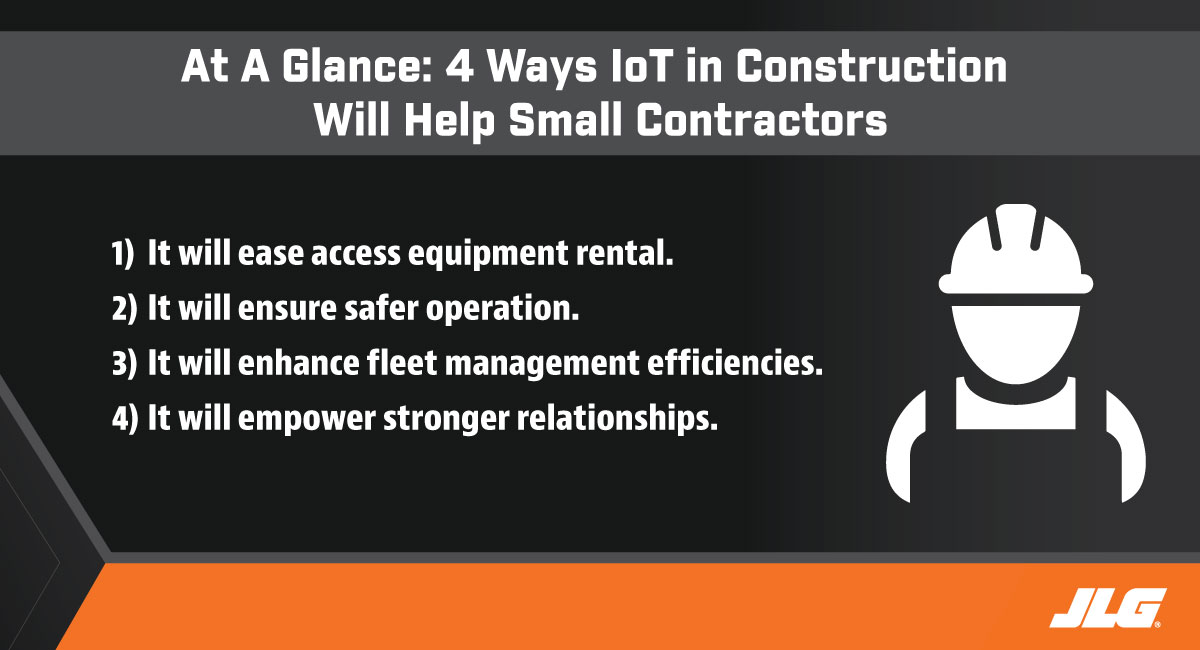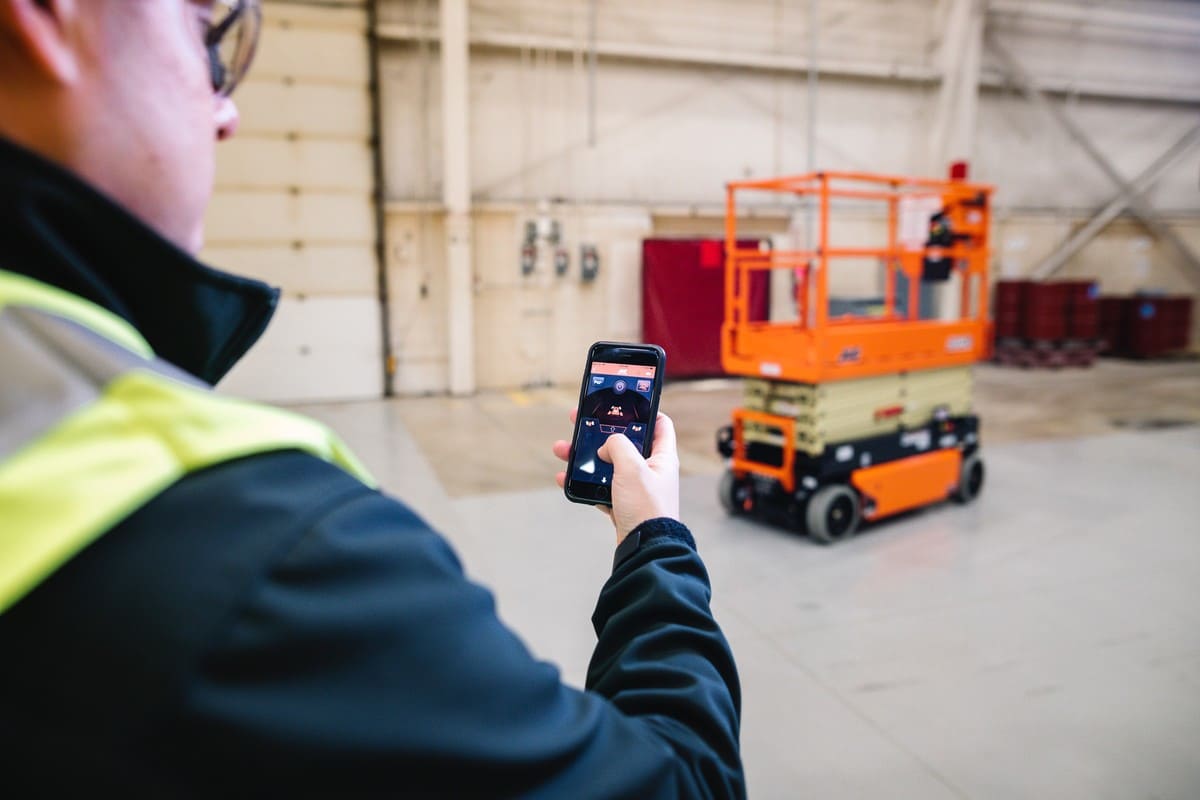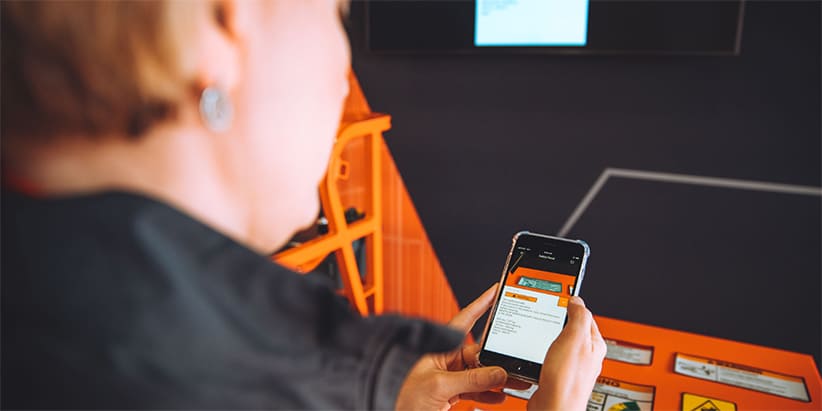When telematics first came on the scene, Jon Shapiro acknowledges its target market wasn’t for the little guy.
“Large contractors had the advantage of being able to be the only ones who could afford any kind of technology,” says Shapiro, senior manager of ClearSky business development at JLG Industries.

But as digitally connected construction equipment is evolving , today’s technology is making it easier for the smallest contractors to access machine information and improve functionality. Shapiro says it’s time for the conversation to change.
“I think that we should stop talking about telematics and talk about IoT in construction,” he says.
What’s the difference? Shapiro says the scope of telematics, primarily focused on the remote monitoring of an asset, is actually quite narrow when compared to what IoT can bring to the table, as the internet connects devices and allows them to communicate to each other.
“It becomes less about a single wireless device on a machine,” Shapiro says. “Look at the evolution from a flip phone to a smartphone. That's really the evolution of telematics to IoT.”
The benefits of IoT in construction will help small contractors be more competitive and solve common problems, he says.
“It's really changing the whole market,” Shapiro says. “It’s finally looking at the medium and small contractor.”
How exactly will it do that? Read on to find out.
How IoT in Construction Will Change the Game for Small Contractors
One of the most significant changes from when telematics was first introduced compared to today is how accessible machine information is to contractors.
With the sensors integrated into new MEWPs and telehandlers, all contractors need is a smartphone to tap into a wealth of information and services right at their fingertips.
“The hardware is readily available to everyone,” Shapiro says. “The apps work well on a phone, and the cost has come way down.”
In the near future, Shapiro says any size contractor will be able to rent and manage access equipment with ease.
“Everything you need to do, you should be able to do with your mobile device,” he says. “You're pushing things that were not in sight for the small contractor, and you're making all of this available to them via the use of technology.”

Easing Equipment Rental
For example, Shapiro says IoT in construction will simplify the rental process for access equipment for a small contractor.
Using the JLG Augmented Reality app, a contractor could walk through the process of selecting equipment by answering questions related to the job and then visualizing the equipment in the space if needed.
“Maybe the contractor doesn't know what they need to get the job done,” Shapiro says. “So it helps them to understand not just what they're trying to accomplish, but also what is the correct piece of equipment.”
Apps can guide contractors with simple questions, such as:
- Have you ever used this equipment before?
- How high do you need to go with this piece of equipment?
- Will you need one person or two in the platform?
“Then let the app drive the customer to a recommendation,” Shapiro says.
Then the contractor can locate the appropriate piece of equipment at a nearby rental store and ideally check out through his device.
“So now a small contractor with a pickup truck and a little bit of information and knowledge can just go right up and rent a boom from a Home Depot and keep it for a day,” Shapiro says.
When it’s time to return the equipment, contractors could extend the rental or complete the off-rental process by mobile device in the future as well, Shapiro says.
“Maybe when they're done renting it, they scan a QR code like when you drop off your Redbox movies,” he says.

Promoting Safe Operation
This equipment connectivity can also help ensure small contractors have proper training or let them know where to get it by asking screening questions and informing them of the ANSI A92 standard requirements for MEWPs, prior to allowing the rental to proceed.
In the future, apps could also connect operators to familiarization and training resources.
“Then if the customer says I need some familiarization videos ... I can connect right to the JLG app, and I can get a quick YouTube video,” Shapiro says.
Once a contractor confirms he can operate the equipment safely, digital technology takes it a step further by allowing users to load and unload scissor lifts remotely and operate them in confined spaces with the JLG™ Mobile Control app.
If an operator has questions about the equipment during its rental, Shapiro says users should be able to communicate in an app and service technicians can remotely log into the machine and diagnose any problems.
Elevating Equipment Management
Small contractors will also see the benefits of IoT in construction in the management and service of their access equipment.
Shapiro says contractors should expect to have information about how much the equipment is being used, where there equipment is located, and who's operating the equipment.
In addition, they could check if the battery is charged, complete daily inspections, and troubleshoot issues.
Just the insights into battery information alone will be tremendously helpful for small contractors, Shapiro says.
“The industry itself gets more electric scissors returned because the customers don't fully
charge the battery, so they think the thing is broken,” he says.
Shapiro says IoT in construction is needed to help address this challenge, especially since construction equipment is increasingly moving to hybrid and electric power.
As both technology and connectivity improve, Shapiro says this will only continue to enhance the serviceability of access equipment as well. The implementation of 5G networks can handle larger data sets, which will allow for remote service capabilities previously unimaginable.
“In the future, if I'm repairing a boom, you could use Google glasses, and you can see a breakdown of the parts,” he says. “You can actually even look at a video on your glasses as to how to repair this part.”
How Connectivity Will Improve Customer Service
While some rental companies already offer apps and digital services for their customers, Shapiro says OEMs can have an instrumental role in helping the industry along, particularly with independent rental companies.
“Rental stores can integrate with what JLG has done already, and I think it’s much more effective that way,” he says.
This may mean that JLG provides an interface to a rental store’s app or mobile ecommerce site. It would call for OEMs and rental companies to work more closely together on their customer tools, he says.
“I really think that an open sharing of information is just the way the world is really moving,” Shapiro says. “Rental stores don’t know the equipment the way the OEM does. They are going to rely on them for connectivity features.”
In turn, this should strengthen the relationship that contractors have with the rental companies they use, because of the productivity benefits connectivity will provide.
“All of this is helping to add to not just the experience of renting the equipment, but also the whole ecosystem itself of being connected together,” Shapiro says.
Want to stay up to date with industry news and trends similar to this? Make sure you subscribe below to receive monthly updates from Direct Access with newly posted content so you never miss important information.